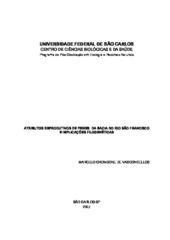| dc.contributor.author | Vasconcellos, Marcelo Grombone de | |
| dc.date.accessioned | 2016-06-02T19:29:03Z | |
| dc.date.available | 2007-08-20 | |
| dc.date.available | 2016-06-02T19:29:03Z | |
| dc.date.issued | 2007-03-29 | |
| dc.identifier.citation | VASCONCELLOS, Marcelo Grombone de. Atributos reprodutivos de peixes da bacia do rio São Francisco e implicações filogenéticas. 2007. 159 f. Tese (Doutorado em Ciências Biológicas) - Universidade Federal de São Carlos, São Carlos, 2007. | por |
| dc.identifier.uri | https://repositorio.ufscar.br/handle/ufscar/1586 | |
| dc.description.abstract | In the present study there are presented the reproductive attributes of 12
species from São Francisco river basin, obtained through the hipophysation and
manual fertilization of the oocytes. Later the registered data were added to more 23
species, totalizing 35 species. The total data were submitted to the clustering
analysis resulting in groups with recognized phylogenetic proximities. The principal
component analysis were applied to quantitative and categorical variables resulting in
the formation of two great dissimilary groups: one formed by species that presented
similar atributtes in relation to the length of the larva newly hatched LTL ,to the
adhesiveness of the eggs ADESIOV, to the low relatively fecundity FRG, to the
absence of larval movements MOVELAR and to high values for the hatch in hourdegree
TE. The other group was formed by species that presented similar atributtes
in relation to the total length of females LT, to the absolute fecundity FA, to the
presence of larval adhesive organ and vertical larval movements in the water,
ADESILAR and MOVELAR, respectively. It is argumented that these two basic
reproductive patterns are the polar principles of the different conditions of the
qualitative and quantitative reproductive characters that they are so close as more
proximities among the species, with rare exception as the Pseudopimelodidae . It
was possible to do inferences about the condition of the in Characiformes,
Siluriformes and Gymnotiformes, that had your origin, in hypothesis, from nest protoguardadores. | eng |
| dc.description.sponsorship | Universidade Federal de Sao Carlos | |
| dc.format | application/pdf | por |
| dc.language | por | por |
| dc.publisher | Universidade Federal de São Carlos | por |
| dc.rights | Acesso Aberto | por |
| dc.subject | Ostariophysi | por |
| dc.subject | Peixe - reprodução | por |
| dc.subject | Filogenia | por |
| dc.subject | São Francisco, Rio, Bacia | por |
| dc.subject | Pisces | eng |
| dc.subject | Hypophysation | eng |
| dc.subject | Reproduction | eng |
| dc.subject | Phylogeny | eng |
| dc.subject | San Francisco river basin | eng |
| dc.title | Atributos reprodutivos de peixes da bacia do rio São Francisco e implicações filogenéticas | por |
| dc.type | Tese | por |
| dc.contributor.advisor1 | Verani, Nelsy Fenerich | |
| dc.contributor.advisor1Lattes | http://lattes.cnpq.br/1862746100743391 | por |
| dc.description.resumo | Neste trabalho são apresentados os atributos reprodutivos de 12 espécies da
Bacia do Rio São Francisco, obtidos através da hipofisação e fertilização manual dos
ovócitos. Posteriormente os dados registrados foram somados aos dados
registrados para outras 23 espécies, totalizando então 35 espécies analisadas pelas
técnicas de análise multivariada de agrupamentos, resultando em grupos com
afinidades filogenéticas reconhecidas, e dos componentes principais, aplicadas
sobre variáveis quantitativas e categóricas resultando na formação de dois grandes
grupos dissimilares: um cujo as espécies foram agrupadas principalmente por
atributos como comprimento da larva recém eclodida LTL, adesividade dos ovos=
ADESIOV, baixa fecundidade relativa=FRG, Ausência de movimentos larvais=
MOVELAR e altos valores para a eclosão em horas-grau =TE; e outro cujo as
espécies se agruparam em função de variáveis como FA= fecundidade absoluta,
LT= comprimento total de fêmeas, presença de órgão adesivo larval e movimento
larval na coluna d`água, ADESILAR e MOVELAR, respectivamente. Argumenta-se
que estes dois padrões reprodutivos básicos sejam os polarizadores das condições
distintas nos atributos quantitativos e qualitativos em peixes da bacia do rio São
Francisco para as quais se registraram caracteres tão próximos quanto mais
próximo o parentesco entre as espécies, com raras exceções como em
Pseudopimelodidae , sendo possível a realização de inferências quanto a condição
dos atributos reprodutivos se plesiomórficos ou apomórficos em Characiformes,
Siluriformes e Gymnotiformes, que em hipótese tiveram sua origem a partir de
grupos proto-guardadores de ninho | por |
| dc.publisher.country | BR | por |
| dc.publisher.initials | UFSCar | por |
| dc.publisher.program | Programa de Pós-Graduação em Ecologia e Recursos Naturais - PPGERN | por |
| dc.subject.cnpq | CIENCIAS BIOLOGICAS::ECOLOGIA | por |
| dc.contributor.authorlattes | http://lattes.cnpq.br/6281371147401391 | por |
